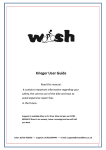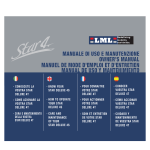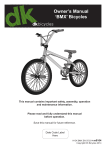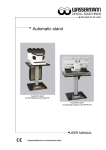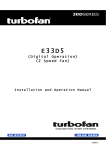Download Karoo User Guide
Transcript
Karoo User Guide Please read this manual. It contains important information regarding your safety, the correct use of the bike and how to avoid expensive repair fees in the future . Support is available Mon to Fri from 10am to 5pm on 01702 684444 If there is no answer, leave a message and we will call you back. Sales: 01702 435566 — Support: 01702 684444 — E-mail: [email protected] 1 The Karoo from Woosh The Karoo is a strong sturdy bike with a good range which can be used for commuting. It has a 13Ah battery which means that distances of 50+ miles can be achieved on a single charge in ideal conditions. If you rely heavily on the throttle and do not put much effort in yourself, then the battery will run down more quickly and the distance able to be travelled on a single charge will be reduced accordingly. The Karoo should be used on roads and cycle paths only, it is not suitable for off-road use and should not be used in competition events. It must not be used for jumping, stunting or aerobatic activities and should not be ridden through deep puddles or fords. Incorrect use of your bike could result in injury and will void your warranty. You must be a minimum of 14 years of age to ride an electric cycle in the UK The maximum rider weight is approx. 108kg/17 stone, and it is suitable for riders 5’8 and upwards. Before you ride your bike, and for your ongoing safety, familiarise yourself with the “user manual” and the “maintenance manual”. There are many components on the Karoo, and it is critical that they are checked regularly and maintained where necessary. Details of how to maintain the various aspects of your bike are included in the “maintenance manual”. If you have any issues which are not covered by the manuals, it is likely that you would need to enlist the help of a professional. Most people don’t have a complete set of tools for maintaining a bike, so things like adjustments to the bottom bracket will need to be done by your local bike dealer. You should enlist the help of your local dealer whenever something needs adjusting that you are not able to do yourself. Your safety is paramount, so you must ensure that the bike is maintained in the correct manner, if in doubt, consult your nearest bike dealer. 2 Important Safety Notice — please read Your bike has had a full electrical check before despatch. It has also had a general mechanical check, but you need to ensure yourself that when you complete the assembly of your bike, that you also check the whole bike over before riding it. You should be prepared to do this yourself, or if you are not sufficiently experienced, ask a local bike shop to do this for you. A typical fee for this would be around £35 A full inspection should include (but is not limited to): Ensure that the brakes are set correctly and work properly. All nuts, bolts, major fixings, spokes and cranks etc. are tight and/or suitably adjusted. Both wheels are properly trued. Headset/stem properly is secure and properly adjusted. Cranks are tight. Bottom bracket properly adjusted. • Pedals, saddle and handlebars are correctly fitted and properly secured. See the maintenance manual for how to adjust and maintain the various components of the bike. Please note that failure to carry out these checks properly could result in serious injury for which Woosh Bikes Ltd will not be held liable. If you have any doubts about your own ability to perform the necessary checks, we strongly recommend you visit your local bike shop and pay their fee. If you are unable to take your bike to a local bike shop there will almost certainly be a mobile bike technician in your area who will come to your home or office and do this for you. Visit www.cycletechuk.com for a full national listing. You will need the following tools to finish the assembly of your bike: 4mm allen key—fitting the handlebars 5mm allan key—adjusting height of seat-post 15mm spanner—fitting the pedals You will need additional tools if you are going to maintain the bike yourself. It’s cheaper to purchase a few tools and follow the guides in the maintenance manual than it is to pay a bike shop to maintain your bike several times per year. 3 Unpacking: Ideally two people are required to unpack the bike, though the Karoo is not as heavy as some of our other bikes. Keep the carton upright as shown, then remove the shipping straps, and cut any tape seals and open the carton. Before lifting the bike out of the box, remove the polystyrene packing piece over the rear wheel and also take out the saddle/seat-post from the other end of the box. Lift the bike holding the rear wheel and the crossbar. Do NOT lift it by the front wheel (which is strapped to the bike) as you may scratch the frame if you do this. Lean the bike against a wall or other sturdy surface. Do NOT destroy the carton as it will be needed if the bike has to be returned for any reason in the future. You will find a small box in the bottom of the carton, this contains your pedals and charger, spoke tool and a bell. See the maintenance manual for how to use the spoke tool. Once you have the bike out of the box, detach the wheel and remove all of the remaining packaging. The Karoo comes mostly assembled, and so requires just a few steps to complete the basic assembly of the bike. Fit the handlebars first so that they are out of the way and will not scratch the frame whilst the rest of the bike is assembled. The handlebars will also serve to help steady the bike if you flip it upside to fit the front wheel. To fit the handlebars, first undo the four bolts securing the clamp using a 4mm allen key (see photo below-left), fit the bars into position and re-fit the clamp. Before you tighten the clamp fully, set your handlebars in the desired position (with the brake levers also in a comfortable position) and then finish tightening the bolts. You are now ready to fit the front wheel. Warning: It is extremely important to ensure that the handlebars are properly secured. If they were to rotate or otherwise move unexpectedly during use, it could result in an accident and/or serious injury. If you have any doubts regarding the correct configuration of this part (or any other part of the bike), you should take your bike along to your nearest bike dealer and have them prepare it for you (at your cost). 4 Fitting the front wheel: You can fit the wheel in one of two ways, you can either flip the bike upside down and drop the wheel into position (easier), or you can lower the forks on to wheel (more fiddly). Before fitting the wheel to the bike, you will first need to fit the skewer/quick-release clamp. The skewer consists of the spindle (with clamp on one side), two springs and a tension nut. Remove the tension nut and one of the springs, and then slide the skewer through the wheel so that the clamp-end is on the opposite side of the wheel to the rotor (brake disc). Fit the other spring back into position and then replace the tension nut, giving just a few turns to secure it so that it doesn’t come off. Now lower the wheel carefully into position ensuring that the rotor is on the correct side and that it sits properly between the callipers. Ensure that the wheel is fully seated and then tighten the tension nut until the clamp has significant resistance when attempting to close it, you may need to open the clamp and make adjustments to the tension nut several times before you reach the optimum clamping force. The clamp should be reasonably difficult to close to ensure that the wheel is properly secured when the clamp is engaged. 5 Seat-post/saddle: Slide the seat-post into position and then tighten the bolt with a 5mm allen key to secure it. To adjust the height of the saddle in the future, loosen the bolt, set the desired height tighten the bolt to lock it in position. If you find that although the bolt is loosened, the seat-post does nto move, you may need to press on the bolt with your thumb, this will release the wedge on the opposites side which claps the post in place when the bolt is tightened. Pedals: Important—the pedals fit a specific side of the bike. If you attempt to fit the pedals to the wrong side, you will damage the threads on the cranks. The pedals are marked ‘L’ (left) and ‘R’ (right) which indicates the side of the bike the pedal is for. To determine which pedal is for which side, see the pictures below showing where this marking is found. In case you are unable to read the lettering, the left pedal has a ribbed/cerated section (see photo below-right) which the RIGHT pedal does not have. Fit each pedal into position and finger-tighten, then use a 15mm spanner to secure the pedals in place, tighten to approx. 40Nm (see torque/tightness guidelines in the maintenance manual). 6 Charging/locking the battery: The battery will likely be only partially charges when you receive the bike. You should fully charge the battery before using your bike. The battery can be charged on the bike or it can be removed and charged separately. The socket used to charge the battery is located on the right side near the top—see photo below-left. Simply lift the weather-proof cover and insert the charger into he socket, then switch the charger on at the mains. The charger has a light on it which is RED while charging, which then turns GREEN when charging is complete. A full charge from flat can take up to 10 hours. The battery lock is located on the opposite side to the charger socket (see photo above-right) and needs to be turned fully anti-clockwise to unlock the battery. When unlocked, the battery is simply slid upwards towards the front of the bike a little and then it can be lifted clear of the bike. Reverse the procedure to put the battery back on the bike, do not forget to lock the battery. On the top of the battery is a meter (see photo below-left), this is used to give a rough indication of the battery status, to activate the meter, press the button in the middle. The more lights that are lit, the more capacity remains in the battery. The red light on the left of this meter is always RED, it is just to indicate that if this is the only light left, you should charge it immediately, this light does not ever go GREEN. Remember to separate your keys, Woosh Bikes is not able to supply replacements if you lose them. 7 Important: Although our bikes are checked prior to despatch, you must fully inspect your bike again yourself before riding it, and satisfy yourself that it is correctly assembled and safe to ride. If you are not absolutely sure about any aspects of your bike, you should take it to your nearest bike shop to have it checked before riding it. Obviously the bike shop will you charge for this service. Woosh Bikes not reimburse you for these costs. Before riding your bike, perform the checks and set up your bike as outlined in the maintenance manual. Check that all fixings and major components are tightened sufficiently. Check that all nuts, bolts, rear carrier fixings, handlebars and seat-post/saddle are also sufficiently tightened. The tyres should be inflated to approx. 80psi on this model. You must also ensure that your brakes are working correctly before you set off. If you are unsure how to adjust your brakes yourself, refer to the maintenance manual that came with your bike for instructions. If you prefer, you can have your local bike shop adjust them for you. The brakes are the same as you would find on a regular bike and so most bike shops should be able to adjust them for you. You would have to pay them for this service. See the preparation/maintenance manual for details on how to adjust/maintain your bike and its components. 8 Riding the bike\Getting started To begin using the bike, press the ’+’ button on the control panel (see below-right), the bike is now effectively on, and if you ride it in this state, the motor will provide assistance when pedalling. The twist-grip is NOT active with assist-levels 1-6 (see advanced features on the next page). To vary the amount of assistance provided by the motor when pedalling, use the ’+’ and ’-’ buttons to move up/down through the assistance levels. The bike will always default to level one when you first power up the bike. To switch off the display when your journey is complete, press AND hold the ‘+’ button for 4 seconds. There are many more features of the control panel which will be covered in more detail on the next page, the information provided so far is just enough to get you up and running as quickly as possible. The motor will only assist you up to 15mph. Though of course you are free to pedal as fast as you like (beyond 15mph if you wish), but the motor will not help you beyond the 15mph limit. This limit is in accordance with current UK law. The Karoo has a “Start-Aid” function which is activated by pressing AND holding the ‘-’ button for two seconds. This will start the bike moving without pedalling up to a maximum speed of just under 4mph, basically enough to get you started at junctions etc. Your bike features 8 speed gears with an index shifter. To change gear, simply press (with your thumb) the lever shown in the photo below—this will select the lower gears. To select the higher gears, press the lever that rests under your trigger finger. When changing gear, change one gear at a time, and wait until said gear is properly engaged before changing to the next. 9 Control Panel—Advanced Features 1. + / - Buttons 2. Automatic Mode Indicator 3. Total Distance 4. Single Trip Distance 5. Single Trip Time 6. Remaining Battery Capacity 7. Kilometre/Mile 8. Current Speed 9. Assistance Level 1. On/Off Function—Press the ‘+’ button to turn on the bike. Press and hold the ‘+’ for approx. four seconds to turn the electrics off. 2. Backlight—With the panel already switched on, press and hold the ‘+’ button for two seconds to turn on/off the backlight. 3. Assistance Level—Adjust the level of pedal-assistance using the ‘+’ and ‘-’ buttons 4. Start-Aid Function—Press and hold the ‘-’ button to activate the Start-Aid function, this will start the bike moving without pedalling up to a maximum speed of just under 4mph. 5. Clear Single Trip Time and Distance– Press and hold both buttons together for three seconds. 6. Display Modes—To switch between “Total Distance”, “Single Trip Time” and “Single Trip Distance”, press (but do not hold) both buttons to cycle through the modes. The Karoo also features a special mode where the pedal-assist feature is disabled, but the twist-grip is available, and will propel you from a standing-start as well as allow you to cruise along. To activate this mode, press the ‘-’ button (repeatedly if necessary) until the assistance level shows zero. The twistgrip is located on the right side of the handlebars (shown below-left). When the twist-grip is pulled fully, the motor will provide the most assistance. 10 DECLARATION OF CONFORMITY Woosh Bikes Product name Electrically power assisted cycle Commercial name(s) Woosh Sirocco Woosh Sundowner Woosh Sirocco CDL Woosh Big Bear LS Woosh Big Bear Woosh Gale Woosh Krieger Woosh Zephyr CDN Woosh Zephyr B Woosh Gallego Woosh Petite Woosh Karoo Woosh Sant Ana Woosh Sant Ana CD/CDL Manufacturer, address Made in China for Woosh Bikes Ltd 42-46 Queens Road, Southend-on-Sea, Essex, SS1 1NL, UK The product (system) identified above is in conformity with the listed European Directive(s). The following table identifies the applied standards and the conformity assessment procedure. EMC DIRECTIVE TWO or THREE-WHEEL MOTOR MACHINE DIRECTIVE 2004/108/EC VEHICLES DIRECTIVE 2006/42 EC OJ DEC. 2004 L 390/24 2002/24/EC OJ MAY 2006 L 157/24 OJ May 2002 L 124/1 Applicable X Non Applicable Non Applicable X Applicable Applicable X - Applied Standards - Applied Standards - Applied Standards EN 15194 EN61000-4-2 EN 55022 Date 01/01/2013 Signature EN 15194 Non Applicable EN 15194 Authorised representative Director—Woosh Bikes Ltd 11 Woosh Support: Be sure to check the FAQ section on our website before calling as the answers to the most common queries are there and you may find that the solution to your problem is already online. If you do need to get in touch, our contact details are below. It can sometimes be useful to see the issue you have, so if possible, email a couple of photos illustrating the problem and we’ll get back to you as soon as we can, usually within a couple of hours on weekdays. Support staff are not available at the weekends, though if you send an email, it will normally be read on the following Monday morning. If you need support on a bike purchased from our Cambridge outlet, please note that you should call our Southend office on the number below. Support articles and FAQ’s: www.wooshbikes.co.uk/?support Email: [email protected] Telephone: 01702 684444 (If there is no answer, leave a brief message and contact no. and someone will call you back asap). Support staff are available 10am to 5pm Monday to Friday. © 2015 Woosh Bikes Limited 12













